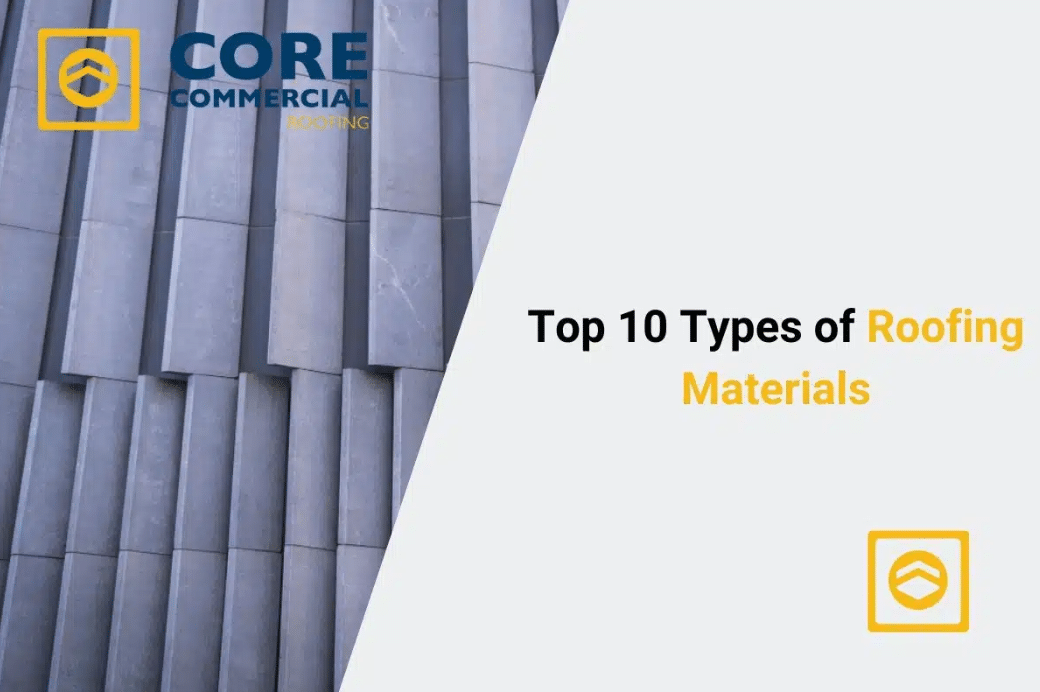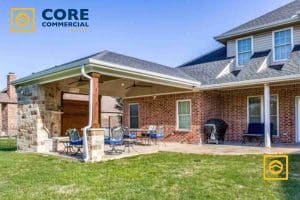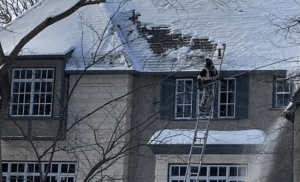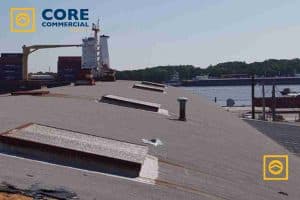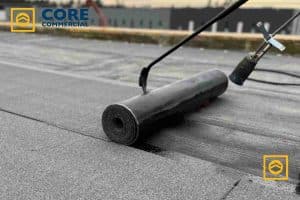Choosing the right roof is one of the most important decisions homeowners make. Your roof not only protects your home from the weather, but it also affects energy bills, comfort, and curb appeal. With so many options, it can feel overwhelming to decide which material is best. Among the many choices, asphalt shingles stand out as one of our favorites because they balance affordability, style, and durability for most homes. Still, every material has unique strengths, and the right choice depends on your budget, location, and long-term goals. This article will walk you through the top 10 types of roofing materials, explaining the pros, cons, and costs in simple terms. By the end, you’ll feel confident about choosing a roof that keeps your home safe, looks great, and provides lasting value.

Table of Contents
1. Asphalt Shingles: The Most Popular Choice
Asphalt shingles are the most common roofing material in the United States, and for good reason. They’re affordable, widely available, and easy to install, making them a top pick for homeowners who want a balance of cost and performance.
- Pros: Asphalt shingles come in a wide variety of colors and styles, so they can match almost any home design. They are relatively simple to repair or replace, and most brands come with warranties that range from 20 to 30 years. Another benefit is their versatility in different climates.
- Cons: While durable, they don’t last as long as some higher-end options like metal or tile. Shingles can also be more prone to damage from high winds or extreme temperature changes.
- Costs: Typically $5,000 to $10,000 for a full roof replacement, depending on size and location.
Asphalt shingles remain the go-to choice for many homeowners who want an affordable roof that still delivers good value.
2. Metal Roofing: Modern and Durable
Metal roofing has become more popular in recent years thanks to its modern look and impressive durability. It’s often made from aluminum, steel, or copper, each with unique qualities.
- Pros: Metal roofs can last 40 to 70 years, making them one of the longest-lasting materials. They reflect sunlight, which can reduce cooling costs in the summer. They’re also fire-resistant and can handle harsh weather like heavy snow or strong winds.
- Cons: The upfront cost is higher compared to asphalt. Some homeowners find them noisier during rain, though proper insulation can fix this. Dents from hail may also be a concern
- Costs: A typical installation ranges from $15,000 to $30,000, depending on size and metal type
If you want long-term performance and energy savings, a metal roof is worth considering
3. Clay Tiles: Classic and Elegant
Clay tile roofs are common in areas with warm, dry climates and homes with Spanish or Mediterranean styles.
- Pros: Clay tiles are beautiful and add timeless charm to a home. They are extremely durable, lasting 50 years or more when maintained properly. They are also resistant to fire, rot, and insect damage.
- Cons: The biggest drawback is weight. Clay tiles are heavy, meaning your roof structure must be strong enough to support them. They can also be more expensive and fragile if walked on.
- Costs: A full clay tile roof can cost $20,000 to $40,000 or more, depending on the home.
For homeowners who want both style and longevity, clay tiles are an excellent choice.
4. Concrete Tiles: Strong and Versatile
Concrete tiles are often used as a more affordable alternative to clay. They mimic the look of clay or slate but come at a lower cost.
- Pros: Very durable, lasting 40 to 50 years with proper care. They’re versatile in style and color, and they perform well in harsh climates.
- Cons: Like clay, concrete tiles are heavy and may require roof reinforcement. They can also absorb water, which may lead to mildew or color fading.
- Costs: Average installation costs between $15,000 and $25,000.
Concrete tiles provide a strong and attractive option for homeowners who want durability without the higher price of clay.
5. Slate Roofing: Luxury and Longevity
Slate is one of the oldest roofing materials, often seen on historic or upscale homes.
- Pros: Slate roofs can last 75 to 100 years or more, making them one of the most durable materials available. They are fireproof, environmentally friendly, and add stunning beauty to any property.
- Cons: The weight is a major issue, requiring a reinforced structure. Slate is also expensive and must be installed by highly skilled professionals. Repairs can be tricky if matching stones aren’t available.
- Costs: Slate roofing often costs $25,000 to $50,000 or more.
If you’re looking for a roof that can last a lifetime and add unmatched elegance, slate is the top-tier option.
6. Wood Shingles and Shakes: Natural Beauty
Wood shingles and shakes bring a rustic, natural look to a home. Shingles are machine-cut for a uniform appearance, while shakes are hand-split for a more textured style.
- Pros: They provide excellent insulation and blend beautifully into natural surroundings. Cedar and redwood are naturally resistant to insects and decay. With proper care, wood roofs can last 30 to 50 years.
- Cons: They require regular maintenance to prevent mold, rot, or fire hazards. In some regions, fire codes may limit their use. They are also less resistant to extreme weather.
- Costs: Expect $15,000 to $25,000 for a full installation.
Wood shingles and shakes are ideal for homeowners who value natural aesthetics and don’t mind the upkeep.
7. Synthetic Roofing: Smart and Affordable Alternatives
Synthetic roofing materials, such as synthetic slate or composite shingles, are designed to mimic natural materials like wood or stone while providing improved durability.
- Pros: Lightweight, affordable, and designed to resist cracking, warping, and fading. They’re also easier to install and maintain compared to natural options. Many come with warranties up to 50 years.
- Cons: While improving, synthetic materials may not always perfectly match the authenticity of natural slate or wood. Some lower-quality versions may not last as long as promised.
- Costs: Installation usually ranges from $10,000 to $20,000.
Synthetic roofing is a great solution if you want the look of luxury materials without the high cost or weight.
8. Green Roofs: Eco-Friendly and Unique
Green roofs, also known as living roofs, are covered with vegetation and soil on top of a waterproof layer.
- Pros: They reduce heat, improve air quality, and provide natural insulation. Green roofs can help manage rainwater runoff and create a unique aesthetic.
- Cons: They require special installation and maintenance to ensure plants stay healthy and roots don’t damage the structure. The weight and cost are also higher compared to traditional options.
- Costs: Prices vary widely but typically start around $20,000 and can climb depending on complexity.
Green roofs are perfect for environmentally conscious homeowners who want to combine sustainability with style.
9. Solar Tiles: Energy Efficiency Meets Roofing
Solar tiles, also called solar shingles, combine the function of a roof with the ability to generate electricity.
- Pros: They provide clean energy, potentially lowering or eliminating your electric bill. Solar tiles are less noticeable than traditional solar panels and can last 20 to 30 years.
- Cons: Higher cost and limited availability. They may not be suitable for all roof shapes or locations. Efficiency depends on sunlight exposure.
- Costs: Installation typically costs $30,000 or more, depending on the size and energy needs.
Solar tiles are ideal for homeowners interested in renewable energy and modern technology.
10. Built-Up Roofing (BUR): A Flat Roof Favorite
Built-up roofing is most often used on flat or low-slope roofs. It’s made of layers of tar, asphalt, and gravel.
- Pros: Provides excellent waterproofing and durability. It’s relatively low-cost compared to some other flat roof systems and has a long history of reliability.
- Cons: Heavy and not as visually appealing as other options. Installation involves strong odors and requires professional expertise.
- Costs: Generally range from $8,000 to $15,000.
For flat roofs, built-up roofing remains a dependable and cost-effective option.
Final Thoughts
Choosing the right roof isn’t just about price or looks. It’s about protecting your home, improving energy efficiency, and ensuring long-term peace of mind. Whether you choose the affordability of asphalt shingles, the durability of metal, or the timeless beauty of slate, each material has its own benefits to match different needs.
The best roof for your home depends on your budget, climate, and personal style. By understanding the pros, cons, and costs of each option, you can make a confident choice that provides protection and value for years to come.
FAQs
What is the most durable type of roofing material?
Slate and metal are among the longest-lasting roofing options. Slate can last 75 to 100 years, while metal can last 40 to 70 years. Both hold up well against weather, but slate is heavier and more expensive.
What type of roof is the cheapest to install?
Asphalt shingles are usually the cheapest roofing material. They cost less upfront, are easy to install, and still provide good protection.
What type of roof is best for hot climates?
Clay tiles, concrete tiles, and metal roofs perform well in hot weather. They reflect sunlight and help keep homes cooler, lowering energy bills
Which roof is best for cold and snowy areas?
Metal roofs are a great choice for cold climates because snow and ice slide off easily. Asphalt shingles can also work, but may need extra care.
Are wood shingles a good idea for my home?
Wood shingles and shakes look beautiful and provide natural insulation. However, they need more upkeep and may not be allowed in areas with fire risk.
How long does an asphalt shingle roof last?
Most asphalt shingle roofs last about 20 to 30 years. Some upgraded versions can last longer if maintained properly.
Are solar tiles worth the cost?
Solar tiles can reduce or even eliminate electricity bills over time, but they’re more expensive to install. They work best if your home gets a lot of direct sunlight.
What roofing material needs the least maintenance?
Metal, slate, and concrete tile roofs need less frequent maintenance compared to wood or asphalt. They also last longer, which reduces replacement costs.
Can a green roof really help with energy savings?
Yes, green or living roofs add natural insulation, reduce heat, and help control rainwater. They cost more upfront but can lower energy bills and add unique curb appeal.
How do I choose the right roofing material for my home?
Think about your budget, local weather, home style, and how long you plan to stay in the house. A professional roofer can also guide you on what materials fit best for your situation.

